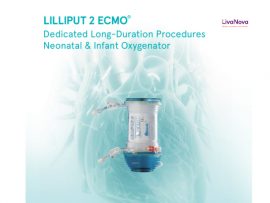Abstract Sublethal damage to red blood cells (RBCs) during extracorporeal life support (ECLS) may lead to RBC loss. Using flow cytometry, phosphatidylserine-positive (PhS+) RBCs and RBC extracellular vesicles were quantified..
Read MoreAbstract Background This study characterized the association of preoperative anemia and intraoperative red blood cell (RBC) transfusion on outcomes of elective coronary artery bypass grafting (CABG). Methods Data from 53,856..
Read MoreAbstract Gastrointestinal complications after cardiac surgery are relatively rare entities but carry a high mortality. We identified over 70 articles written since 2010 using the PubMed database. We included 40..
Read MoreAbstract Background Our goal was to create a simple risk‐prediction model for renal function decline after cardiac surgery to help focus renal follow‐up efforts on patients most likely to benefit...
Read MoreAbstract Although current studies support the use of prophylactic distal perfusion catheters (DPCs) to decrease limb ischemia in patients on venoarterial extracorporeal membrane oxygenation (VA ECMO), methods for monitoring limb..
Read MoreAbstract Objective: Minimally invasive cardiac surgery (MICS) is increasing worldwide. In most cases, the surgical technique includes cannulation of the groin for the establishment of cardiopulmonary bypass, requiring a second..
Read MoreAbstract Venovenous extracorporeal membrane oxygenation is used for respiratory support in the most severe cases of acute respiratory distress syndrome. Blood is drained from the large veins, oxygenated in an..
Read MoreAbstract Background Prospective, trial-based data comparing health-related quality of life (HRQoL) in patients surviving out-of-hospital cardiac arrest (OHCA) through extracorporeal cardiopulmonary resuscitation (ECPR) or conventional CPR (CCPR) are scarce. We..
Read MoreAbstract The intricate management of hemostatic disorders in extracorporeal membrane oxygenation (ECMO) assisted patients poses challenges, particularly when procoagulant administration is necessary. We hereby report the performance of the Nautilus*..
Read MoreAbstract Purpose of review The purpose of this review is to examine high reliability through the lens of a contemporary pediatric heart center, noting that continuous improvement, rather than perfection,..
Read MoreAbstract INTRODUCTION Whole blood resuscitation for hemorrhagic shock in trauma represents an opportunity to correct coagulopathy in trauma while also supplying red blood cells. The production of microvesicles in stored..
Read MoreAbstract Purpose of review To examine the evolving landscape of cardiac surgery, focusing on the increasing complexity of patients and the role of mechanical circulatory support (MCS) in managing perioperative..
Read MoreAbstract Objective To evaluate the efficacy and safety of intrapleural perfusion with hyperthermic chemotherapy (IPHC) in treating malignant pleural effusion (MPE). Methods PubMed, Embase, Cochrane Library, Chinese National Knowledge Infrastructure..
Read MoreAbstract Objective To verify the impact of preoperative levosimendan on patients with severe left ventricular dysfunction (ejection fraction <35%) undergoing isolated coronary artery bypass grafting. Design A meta-analysis. Setting Hospitals...
Read MoreAbstract Introduction: Cardiac disease is associated with a risk of death, both by the cardiac condition and by comorbidities. The waiting time for surgery begins with the onset of symptoms..
Read MoreAbstract Introduction: Adequate cerebral protection for aortic reoperation is challenging and optimal technique is still controversial. Case Report: We report a hybrid cannulation approach to achieve safe cerebral protection..
Read MoreAbstract In a recent issue of Intensive Care Medicine, we read with great interest the article by Moyon et al. [1] who retro-spectively studied the outcomes of immunocompromised patients with..
Read MoreAbstract Purpose: The outcomes of immunocompromised patients with cardiogenic shock treated with venoarterial extra‑corporeal membrane oxygenation (VA‑ECMO) are seldom documented, making ECMO candidacy decisions challeng‑ing. This study aims (1) to..
Read MoreAbstract Right ventricular (RV) assessment has been a long time endeavour but difficult for many reasons, anatomic physiologic and imaging. Recently, new approaches have allowed better understanding of the how-to..
Read MoreAbstract Extracorporeal membrane oxygenation (ECMO) circuit priming procedures are crucial for removing air bubbles and the albumin in priming solution is thought to create a protective layer against blood exposure..
Read MoreAbstract Unfractionated heparin (UFH) was uncovered in 1916, has been used as an anticoagulant since 1935, and has been listed in the World Health Organization's Model List of Essential Medicines...
Read MoreAbstract Heart failure with preserved ejection fraction (HFpEF) constitutes approximately 50% of heart failure (HF) cases, and encompasses different phenotypes. Among these, most patients with HFpEF exhibit structural heart changes,..
Read MoreJoin us at the as we present cutting edge inpatient and operative strategies for improving neurodevelopmental outcomes for children with congenital heart disease. Presented by members of the NeuroCardiac Critical..
Read MoreAbstract Despite improvements in survival after illnesses requiring extracorporeal life support, cerebral injury continues to hinder successful outcomes. Cerebral autoregulation (CA) is an innate protective mechanism that maintains constant cerebral..
Read MoreAbstract OBJECTIVES Postoperative organ dysfunction is common after cardiac surgery, particularly when cardiopulmonary bypass (CPB) is used. The Sequential Organ Failure Assessment (SOFA) score is validated to predict morbidity and..
Read MoreAbstract Critically ill patients sometimes require tandem application of extracorporeal membrane oxygenation (ECMO) and continuous renal replacement therapy (CRRT) which is easier and cheaper. We aimed to transform the kidney..
Read MoreAbstract Purpose Oxygen delivery (DO2) and its monitoring are highlighted to aid postoperative goal directed therapy (GDT) to improve perioperative outcomes such as acute kidney injury (AKI) after high-risk cardiac..
Read MoreAbstract Acute kidney injury represents a significant threat in cardiac surgery regarding complications and costs. Novel preventive approaches are needed, as the therapeutic modalities are still limited. As experimental studies..
Read MoreAbstract Aims Patients with symptomatic aortic valve stenosis are efficiently treated by aortic valve replacement (AVR), using a biological or mechanical valve. For some patients with mechanical valves, the metallic..
Read More
























